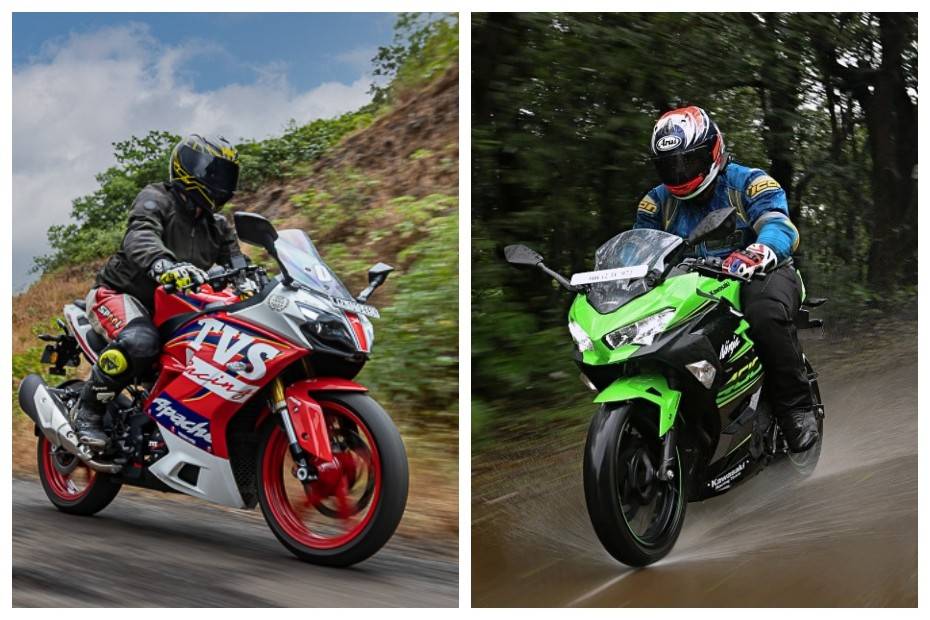TVS Apache RR 310 vs Kawasaki Ninja 400: Image Comparison
Published On Jun 28, 2022 06:15 PM By Nishaadfor Kawasaki Ninja 400
- 398 Views
How does the Indian supersport fare against its newly-launched Japanese counterpart?

With the launch of the Kawasaki Ninja 400, the sub-400cc supersport segment in India has quite some options. One such option is the TVS Apache RR 310. So let’s see how the two supersports match up against each other, through images:


Not much has changed for the TVS Apache RR 310 over the years, in terms of design. It’s still the same striking sub-400cc sportbike that we fell in love with. Its full fairing and bi-LED projector headlamps combine to give the bike a very handsome look. While it gets an all-LED lighting, the Ninja 400 makes do with bulb indicators.
The Ninja 400, on the other hand, features a sharp face housing and aggressive twin LED headlight. This edgy look extends into the side panels, further complimented by a chiseled muscular fuel tank. The bulb turn indicators are embedded into the lower front profile of the side panels.


At the Apache RR 310’s heart is a 312.2cc single-cylinder, liquid-cooled motor making 34PS and 27.3Nm. While it’s substantially down on power, it gets goodies like riding modes and TVS’ GTT (Glide Through Technology) which makes it that much easier to ride in slow moving traffic too.
The Ninja 400’s displacement and cylinder advantage is evident now, as it makes 45PS and 37Nm from its 399cc parallel twin engine, liquid-cooled engine. It also gets an updated slip-and-assist clutch that Kawasaki claims has 20 percent lighter lever action than before.


The 5.5-inch TFT display on the RR 310 can store virtual copies of documents like the bike’s RC card and your driver’s licence. Adding to the new features is a dynamic engine rev limit indicator, day trip meter, and over speed indicator. The Ninja 400, on the other hand, still makes do with a dated semi-digital instrument cluster. It has a clock, gear position indicator, two tripmeters and an average fuel consumption display.


The Apache RR 310 comes equipped with bigger brakes at the front (300mm) and rear (240mm). It also features grippier Michelin Road 5 tyres.
The Ninja 400 makes do with a 286mm semi-floating petal front disc and 193mm petal rear disc. Both the bikes sit on 17-inch wheels wrapped with 110/70 and 150/60 tyres at the front and rear respectively.

Where the RR 310 starts pulling away are the optional add-ons. You can choose between two kits: Dynamic and Race, or get both if you want a complete package. Read about the differences between the two kits and what they have to offer here. The Ninja 400, meanwhile, gets no additional add-on parts.


The Ninja 400 tips the scale at 168kg, making it 6kg lighter than the Apache RR 310. That coupled with the more power it has on tap translates to a much better power-to-weight ratio for the Japanese supersport. It also features a slightly bigger 14-litre fuel tank when compared to the 11-litre fuel tank on the Apache RR 310.
The Kawasaki Ninja 400 is priced at Rs 4,99,000 (ex-showroom) while the TVS Apache RR 310 is priced at Rs 2,65,000 (ex-showroom Delhi), making the Japanese bike Rs 2,34,000 dearer. While the huge price difference is mainly due to the fact that the Ninja 400 is available through the CKD route, you can’t help but feel that it punches above its weight, especially given that there are lower-priced bikes like the TVS Apache RR 310 and the 2022 KTM RC 390 (Rs 3,13,922 ex showroom Delhi), both of which offer more track-focused hardware and cost much lesser. The upcoming BMW G 310 RR will further heat this segment once it’s here.
